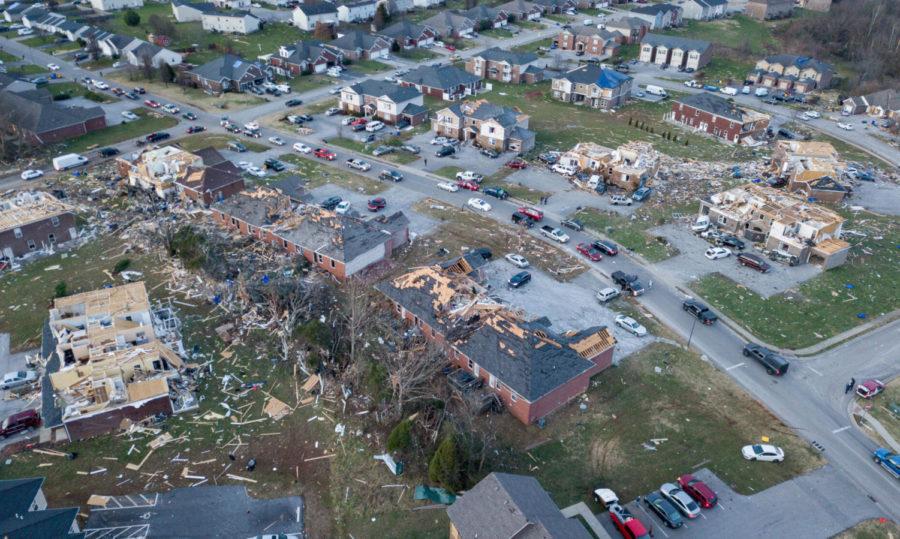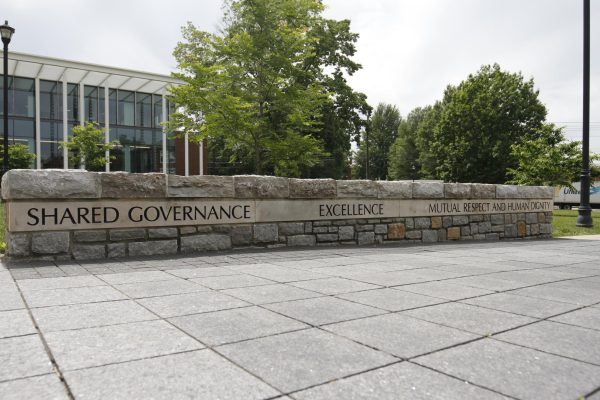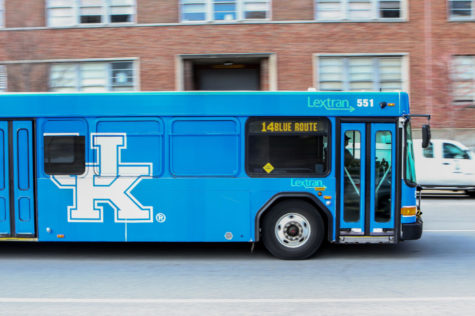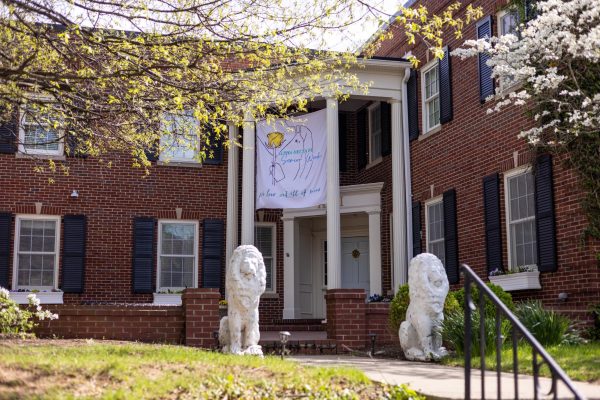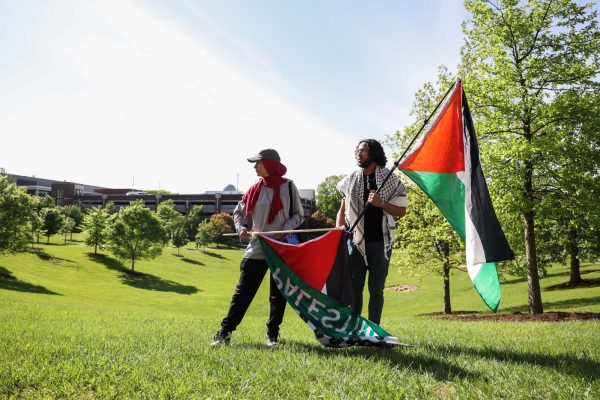The worst tornado in Kentucky history, told through one Bowling Green neighborhood’s survival stories
December 11, 2021
Jessica Mann wasn’t scared when the freight train of a tornado arrived at her window. She didn’t have time. It was only hours after the storm, relatively safe on her neighbor’s couch, water bottle in hand, that the fear hit.
Mann and her husband heard the National Weather Service phone alert in bed, around 1:30 a.m. They ignored it. After all, Bowling Green gets alerts like that all the time, but no tornado had ever actually touched down in the 13 years they’ve lived here. That is, until 10 minutes later, when something sounding like a freight train interrupted their sleep again. Mann said the noise was ferocious, deafening.
“It took us like half a second to realize what was about to happen,” Mann said. “My husband threw me over the side of the bed and then scrambled after me. And in just enough time, because about the time he was scrambling over the bed and jumping on top of me to shield me, our bedroom window and then our living room window both blew in.”
After the worst of it passed, Mann and her husband went into their living room to investigate. Upon realizing the entire room was gone, they threw clothes and shoes on and then ran to hide in the windowless bathroom, preparing to stay until daybreak. Fortunately, their neighbor’s house was untouched, and he eventually came over in the pouring rain to invite them in for the night. Mann grabbed the phones, her husband grabbed their dog, and they left their shell of a home behind.
Mann said the adrenaline of the moment overrode any fear.
“You don’t really have time to be super frightened because you’re like, oh, f–k, okay, so this just happened and is it going to happen again? Because then at that point, I’m like, is there more coming? You know, like, what happens?” Mann said. “We were like, ‘Okay, grab the dog, get into the bathroom, get into the bathtub.’ … So, it was just like, little steps at a time like, get to the bathroom. Okay, good. Alright, check to see what the temperature is. Okay, good.”
On the neighbor’s couch, though, Mann began to cry, thinking about all the bad things that did happen and could have happened, the shock of survival beginning to subside.
“The real terror didn’t hit until after it was all done,” she said. “I don’t know, is that like some weird like, biological thing where like, as a human, you’re just like, ‘Okay, we need to, like, focus?’”
The tornado ravaged the Manns’ house on Spring Creek Avenue like most others in the neighborhood. Their front door flew into the kitchen. The two pillars holding up the front porch ended up in the living room. Glass shards were everywhere. Almost everything was destroyed. But the Manns’ Christmas tree remained standing, ornaments and all.
“Well, it’s a Christmas miracle, I guess,” Mann said. “We can buy new furniture, you know, we can buy new throw pillows, but all the sentimental stuff is actually fine, and nothing was really destroyed that we can’t ever get back.”
The Manns were not the only neighborhood residents with dramatic survival stories after four tornadoes ripped through western Kentucky Saturday morning, wreaking havoc on the region’s communities and infrastructure. One touched down for 277 miles, the longest distance a tornado has ever tracked in the state, Gov. Andy Beshear said.
In an early morning update, Beshear estimated that the tornadoes killed at least 70, and likely more than 100, Kentuckians. The most casualties are concentrated in Mayfield, located in Graves County. While search and rescue efforts continue, there are currently only 40 survivors after a roof collapse at a Mayfield candle factory with approximately 110 people inside crushed dozens of workers.
There have also been multiple deaths recorded in Muhlenberg, Hopkins, Marshall, Warren and Caldwell counties, among others.
A little after midnight, Beshear declared a state of emergency for the commonwealth. He also dispatched 180 members of the Kentucky National Guard and the Kentucky State Police to help in the recovery process and established a Western Kentucky Tornado Relief Fund. Federal aid is incoming as well, after President Joe Biden, Homeland Security Secretary Alejandro Mayorkas and Federal Emergency Management Agency administrator Deanne Criswell accepted Beshear’s request for a federal emergency declaration. This will allow the government to provide greater and quicker resource allocations to western Kentucky. On Biden’s direction, FEMA has already sent response teams to impacted areas in Kentucky, as well as other affected states.
While not ground zero, Bowling Green was still hit hard by the tornadoes. There are at least 11 confirmed fatalities, according to Warren County Coroner Kevin Kirby. At noon on Saturday, over 27,000 Warren County residents were out of power — 44% of tracked customers. But as of Saturday at 9 p.m., power was restored to many, with only around 6,000 residents still waiting for the lights and heat to turn back on. Louisville’s National Weather Service estimated that the tornadoes reached 150 mile per hour speeds when traveling through Bowling Green, qualifying for EF3 tornado status.
If it weren’t for a midnight instinct, Amzie Gray and her baby would not be alive. Saturday afternoon, Gray’s sister, Lanathan Marsh, was surveying the damage to her home on Creekwood Avenue, perpendicular to the Manns’s street. The floor was covered in insulation remnants, and the ceiling barrier between the first and second floor was torn apart, with Gray’s baby’s exposed room visible from the front door entrance.
“She lost everything,” Marsh said, over and over.
Gray hadn’t known about the incoming storm. However, around midnight, she felt a strong need to leave her house with her baby. She listened to her gut, fleeing to her mother’s house less than an hour before the tornado razed her home. The family business also made a narrow escape; the home healthcare agency owned by Marsh and Gray’s father survived its surrounding destruction.
“Our building is literally the only building that’s standing,” Marsh said. “Like, Zaxby’s is right there — destroyed. Like, every business around is destroyed besides his.”
Marsh said the area around Creekwood Avenue saw the worst of the storm. While there are bad spots here and there around Bowling Green, she said there was nothing like her sister’s neighborhood.
Two streets over, Tiffany Latchey’s apartment complex was spared, but her van was not so lucky. Latchey had been driving home from the Warren Central High School weight room when she ran into the tornado — literally.
She was on her way past the Russellville Road Sonic when her friend frantically yelled at her to turn around. She said her life flashed before her eyes.
“I’m shocked, like I’m in a daze, because all you see is pitch black, sh-t moving, electric power lines. So he’s like ‘Tiffany! Hurry up, turn around!’ So I’m putting it in reverse, I’m trying, but the van started rocking and the next thing you know, we just wound up in that field.”
Latchey’s car was totaled, but the tornado encounter left her with only minor bruises and cuts. She hit her head on the dashboard amidst all the chaos. After her friend managed to wake her up and get her out of the car, they ended up leaving Latchey in the field.
“It was so many people that I don’t think they realized they left me, and it was pouring down rain, and I had to hitch a ride from a stranger,” Latchey said. “Luckily, this lady, her and her husband, let me in the car, because it was cold.”
Latchey said she thanks God that she is alive to tell her story.
After the sun rose, the damage to Bowling Green became clearer. Not everyone survived, and those that did have an overwhelming reconstruction process ahead. Mann went with her husband to his family’s house to recharge their phones and spirits before returning to begin cleaning.
They aren’t alone in the effort, though. The Bowling Green community showed eagerness to help. All day, people drove through the neighborhood, but not all came to help. Some were looters, looking to steal televisions and other valuables. Still others were rubberneckers. “I just give them a mean look because that’s shitty to come by and look at everyone’s misery,” Mann said.
However, most had good intentions, offering condolences, food, water and tarps to neighborhood residents.
Several miles away, at South Warren Middle School, over 100 volunteers bustled around, organizing piles of clothes, food, toiletries, toys and other necessities for the tornado victims. The American Red Cross set up dozens of cots for those needing shelter and organized blood drives to help those in the hospital with serious injuries. Jennifer, a Red Cross volunteer, said they’ve been encouraging people to make financial donations to disaster relief to continue the long-term recovery process beyond the first few weeks.
“We’re offering health services and mental health services here. It’s been important,” Jennifer said. “It’s a grieving process. Some people lost loved ones. I have not met anyone so far that has, but they’ve lost their homes. You grieve that just like you grieve the loss of life … It’s okay to be angry. It’s okay to feel guilty. Those are normal.”
Tornadoes are disasters that happen on television, in the Midwest, said volunteer Colin Burnam. Most people never imagine it happening in their community, to the people they grew up with and love.
“We get those warnings all the time around here, and we never really pay much attention,” Burnam said. “But this time, you know, it was a little different. And it was serious. So just having that sudden, kind of that rush, that rush of adrenaline where, okay, what do we need to do? … It’s kind of a scary thing, but at the same time, you have to be able to jump into action so that you can make sure that the best possible outcome for those that you love happens.”
Michelle Jones also spent the day at South Warren volunteering with her daughter. It’s been inspiring, Jones said. She wants everyone in Kentucky and the nation to know how Bowling Green showed up for each other during this disaster with compassion.
Mann echoed that sentiment.
“I think just realizing that we’re all human and realizing that — that’s the best you can do to help your fellow human is just to be kind and reach out a helping hand,” Mann said. “You know, my motto has always been ‘my house, your house,’ and apparently that also extends to when a tornado hits.”









































































































































